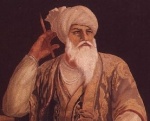Template:AOW359: Difference between revisions
Hari singh (talk | contribs) (Created page with '{{aowh|Bhai Nand Lal}} {{pm|File:Bhainandlal-sml.jpg|Bhai Nand Lal}} '''Bhai Nand Lal''' (c. 1633-1713), was a poet famous in the Sikh tradition and favourite disciple o…') |
Hari singh (talk | contribs) No edit summary |
||
| Line 2: | Line 2: | ||
{{pm|File:Bhainandlal-sml.jpg|[[Bhai Nand Lal]]}} | {{pm|File:Bhainandlal-sml.jpg|[[Bhai Nand Lal]]}} | ||
'''Bhai Nand Lal''' (c. 1633-1713), was a poet famous in the Sikh tradition and favourite disciple of [[Guru Gobind Singh]]. His poetry, all in Persian except for ''Joti Bikas'', which is in [[Punjabi]], forms part of the approved Sikh canon and can be recited along with scriptural verse at Sikh religious [[divan|divans]]. | '''[[Bhai Nand Lal]]''' (c. 1633-1713), was a poet famous in the [[Sikh tradition]] and favourite disciple of [[Guru Gobind Singh]]. His poetry, all in [[Persian]] except for ''Joti Bikas'', which is in [[Punjabi]], forms part of the approved Sikh canon and can be recited along with scriptural verse at Sikh religious [[divan|divans]]. | ||
Nand Lal adopted the pen-name of "Goya," though at places he has also subscribed himself as "Lal," the word being the last part of his name | [[Nand Lal]] adopted the pen-name of "Goya," though at places he has also subscribed himself as "Lal," the word being the last part of his name. | ||
He is | He was a scholar, learned in the traditional disciplines of the time, and his image in [[Sikh history]] is that of a man who loved and venerated [[Guru Gobind Singh]] and has been in turn loved and venerated by generations of [[Sikh]]s. | ||
His father, Munshi Chhajju Mall, | It is thought that he was born in a town called [[Ghazni]] in [[Afghanistan]] and was 23 years older than [[Guru Gobind Singh]]. By caste he was a Khatri, a class distinguished in [[Mughal]] times, like the Kayasthas, for its proficiency in learning and using Persian, which at that time was the language of official business. <!--- | ||
His father, Munshi Chhajju Mall, an official in the secretariat of Shah Jahan's eldest son Prince Dara Shikoh, accompanied the Prince on an expedition to Ghazni in 1639 and was assigned to an army unit stationed there at the end of the operation. He summoned his family from India to join him in Ghazni where Nand Lal spent his childhood and early youth.---> {{aowf|Bhai Nand Lal}} | |||
Latest revision as of 20:16, 30 November 2009
Bhai Nand Lal (c. 1633-1713), was a poet famous in the Sikh tradition and favourite disciple of Guru Gobind Singh. His poetry, all in Persian except for Joti Bikas, which is in Punjabi, forms part of the approved Sikh canon and can be recited along with scriptural verse at Sikh religious divans.
Nand Lal adopted the pen-name of "Goya," though at places he has also subscribed himself as "Lal," the word being the last part of his name.
He was a scholar, learned in the traditional disciplines of the time, and his image in Sikh history is that of a man who loved and venerated Guru Gobind Singh and has been in turn loved and venerated by generations of Sikhs.
It is thought that he was born in a town called Ghazni in Afghanistan and was 23 years older than Guru Gobind Singh. By caste he was a Khatri, a class distinguished in Mughal times, like the Kayasthas, for its proficiency in learning and using Persian, which at that time was the language of official business. .....More

